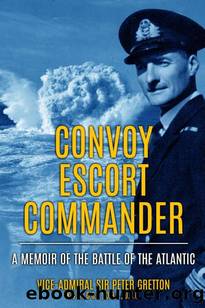Convoy Escort Commander: A Memoir of the Battle of the Atlantic (Submarine Warfare in World War Two) by Sir Peter Gretton

Author:Sir Peter Gretton [Gretton, Sir Peter]
Language: eng
Format: epub
Publisher: Sapere Books
Published: 2021-08-28T23:00:00+00:00
No one can look back on that month [March] without feeling something approaching horror at the losses we suffered. In the first ten days, in all waters, we lost forty-one ships; in the second ten days, fifty-six. More than half a million tons of shipping sunk in those twenty days; and what made the losses even more serious than the bare figures indicate was that nearly two-thirds of the ships sunk during the month were sunk in convoy⦠Where would the Admiralty turn if the convoy system lost its effectiveness? They did not know; but they must have felt, though no one admitted it, that defeat stared them in the face.
To add to our difficulties we were in one of those unpleasant periods of the war when the enemy were able quickly to decypher our codes and cyphers. They could thus get a good idea of the position of most convoys in the Atlantic and made good use of this knowledge. In his book, Admiral Doenitz says that he was also able to read the U-boat situation reports, so that he knew where we thought that his U-boats were! Fortunately for our morale, we were blissfully unaware of all this at the time. Roskill says that the Allies did not achieve unbreakable codes until June 1943, by which time much damage had been done. He also hints that our own code-breakers were not idle, but, again, we had no inkling of what went on at the time.
There was, however, one cheerful aspect to be recorded. At long last, support groups had been formed which could be used to reinforce the escort of convoys which were threatened or attacked. This idea had been considered earlier but shortage of ships had made it impossible to implement. Thus, when the escort-building programme was beginning to show results, the North African invasion demanded a number of special groups to take the invasion convoys to and from the Mediterranean.
Now, by taking one ship from each of the close escort groups, so reducing them to a total size of six ships, it was possible to form four support groups from the sixteen ships so released. At this time, too, the convoys to Russia had been temporarily suspended, and the Home Fleet was able to lend two groups of destroyers which were used in the supporting role. The decision to reduce the strength of the close escort groups required much courage, but it was correct, for we hoped that the support groups could be operated so that one of them was always âaroundâ when a convoy got into trouble, and the reduction in escort strength in fact took place only when attack was unlikely.
So, when we sailed for our convoy at the end of March 1943, we did not know it but the time of test was fast approaching.
Download
This site does not store any files on its server. We only index and link to content provided by other sites. Please contact the content providers to delete copyright contents if any and email us, we'll remove relevant links or contents immediately.
Machine Learning at Scale with H2O by Gregory Keys | David Whiting(4183)
Never by Ken Follett(3793)
Harry Potter and the Goblet Of Fire by J.K. Rowling(3775)
Unfinished: A Memoir by Priyanka Chopra Jonas(3333)
Fairy Tale by Stephen King(3220)
The Man Who Died Twice by Richard Osman(2997)
Will by Will Smith(2793)
Rationality by Steven Pinker(2291)
The Dark Hours by Michael Connelly(2245)
Can't Hurt Me: Master Your Mind and Defy the Odds - Clean Edition by David Goggins(2228)
It Starts With Us (It Ends with Us #2) by Colleen Hoover(2198)
The Storyteller by Dave Grohl(2172)
The Dawn of Everything: A New History of Humanity by David Graeber & David Wengrow(2122)
Friends, Lovers, and the Big Terrible Thing by Matthew Perry(2119)
The Becoming by Nora Roberts(2088)
The Stranger in the Lifeboat by Mitch Albom(2050)
Cloud Cuckoo Land by Anthony Doerr(2035)
Einstein: His Life and Universe by Walter Isaacson(1967)
Love on the Brain by Ali Hazelwood(1965)
